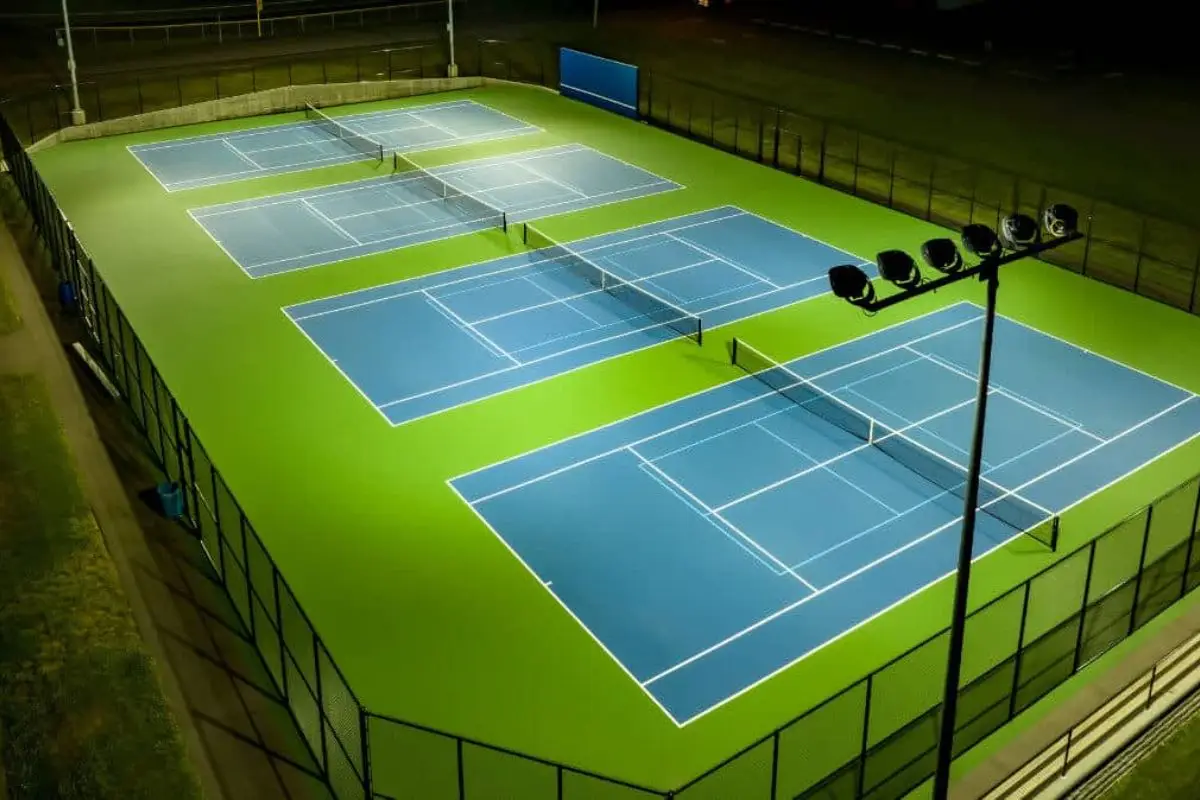Evolution of Pickleball Court Lighting: Pickleball, a racquet sport that blends elements of tennis, badminton, and racquetball, has become a major player in sports. Created in the 1960s, its popularity has soared, especially among Baby Boomers, contributing to its rapid rise in recent years.
Courts are cropping up across various venues—country clubs, city parks, YMCAs, and more. The USA Pickleball Association reports that the number of pickleball venues has more than doubled since 2010. As interest increases, especially in regions like the East Coast, West Coast, and the Great Lakes, the addition of lighting to courts has become a common trend, enabling players to extend their playing time after dark.
Pickleball Court Standards
For an enjoyable and safe pickleball experience, adhering to court standards is essential. Official guidelines, set by the USA Pickleball Association, mandate that courts measure 20 feet by 44 feet for singles and doubles, with a minimum playing surface of 30 feet by 60 feet. The recommended surface dimensions increase slightly to 34 feet by 64 feet.
As for lighting, the standards are specific: luminaires mounted on 20-foot poles should deliver an average of 30 footcandles (fc) with a max/min ratio of 2.0 or less. This lighting configuration ensures uniform illumination, preventing areas of darkness that could disrupt play.
Pickleball Court Lighting Requirements
To achieve optimal visibility, pickleball courts require luminaires mounted at 20 feet in height, ensuring that the ball remains visible even when it arcs high into the air. Lighting levels of 30 fc are essential to see the ball clearly, even during fast-paced rallies.
The max/min ratio of 2.0 guarantees even light distribution, meaning players won’t need to adjust to varying light intensities. A photometric study can be conducted to verify that the lighting system meets these requirements and provides consistent illumination across the court.

Lighting Ordinance Compliance and Building Requirements
Meeting pickleball court lighting standards is just one part of the equation; complying with local lighting ordinances is another. Many communities enforce specific regulations to minimize light pollution and preserve the night sky. Full cutoff lighting ensures minimal up-light and better environmental protection, while dark sky-compliant fixtures, typically with LEDs under 3000 Kelvin, help reduce light pollution.
Additional shielding types, such as partial, full, and backlight shielding, are used to prevent light from spilling onto neighboring properties. Communities may also impose restrictions on pole height, with some requiring that poles withstand high wind speeds, especially in areas prone to severe weather.
Benefits of LED Lighting for Pickleball Courts
LED lighting has transformed the way pickleball courts are illuminated, offering significant energy savings and durability. LEDs use up to 75% less energy than traditional metal halide lights, and their lifespan extends to over 200,000 hours compared to only 2,000-3,000 hours for metal halide fixtures.
These lights also handle outdoor conditions better, resisting shock and vibration, which makes them ideal for outdoor sports. Additionally, LED lighting requires less maintenance, reducing costs and downtime.
Choosing the Right LED Lighting
Selecting the right LED lighting involves several considerations to maximize court performance and player satisfaction. For outdoor courts, an illumination level of 30 fc is required, while indoor courts should have at least 50 fc. Color temperature is another key factor: cooler temperatures between 5000K and 6500K are ideal for commercial spaces, providing bright, daylight-like light.
Residential installations often favor warmer light between 3000K and 4000K for a softer, more inviting glow. Additionally, the choice of fixtures and their mounting height—typically 20 feet for outdoor courts—ensures proper light distribution without causing glare or shadows.
Lighting Solutions for Pickleball Courts
For outdoor courts, LED lights with advanced optics are often mounted on poles or around the perimeter, ensuring even illumination across the playing surface. Indoor courts benefit from ceiling-mounted fixtures that evenly distribute light.
To optimize energy efficiency, it’s important to install a control system, which can include scheduling, photocells, and motion sensors. These systems ensure that lights are only on when needed, reducing energy consumption and extending the life of the lighting system.

Installation and Maintenance
Proper installation and ongoing maintenance are critical to ensure the longevity and effectiveness of pickleball court lighting. Hiring a qualified professional for installation ensures the system meets local and national standards.
Although LEDs are known for their durability, periodic inspections are still recommended to identify and address any issues before they impact performance. The correct mounting height and angle of the fixtures are also essential to ensure the lights provide uniform coverage without creating shadows or dark spots on the court.
APTA Sports Lights to Illuminate the Pickleball Court
Access Fixtures’ APTA LED sports lights are a top choice for pickleball court illumination. These lights meet USA Pickleball Association standards and offer advanced optics, which direct light efficiently while minimizing spill.
With their long lifespan, energy efficiency, and ability to meet dark sky requirements, APTA lights are designed to provide powerful, reliable illumination, ensuring an optimal playing experience for all.
News in Brief: Evolution of Pickleball Court Lighting
Pickleball continues to grow in popularity, leading to a rise in courts equipped with lighting to extend playtime after dark. The USA Pickleball Association reports a significant increase in venues across the country, with lighting becoming a standard addition for indoor and outdoor courts.
With specific requirements for light levels and distribution, the shift to LED technology has transformed how courts are illuminated, offering energy savings, durability, and improved visibility for players.
Local lighting ordinances and dark sky regulations must also be considered when installing new systems, ensuring a balance between adequate illumination and environmental protection.
ALSO READ: Pickleball Takes Center Stage at Lakeshore Park with New Lighted Pickleball Courts

